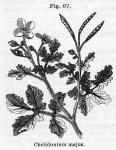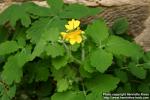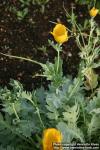Chelidonium (U. S. P.)—Chelidonium.

 Note: Chelidonium is dicey; it's been implicated in liver disease. Don't use it. -Henriette.
Note: Chelidonium is dicey; it's been implicated in liver disease. Don't use it. -Henriette.
"The entire plant, Chelidonium majus, Linné"—(U. S. P).
Nat. Ord.—Papaveraceae.
COMMON NAMES: Celandine, Chelandine, Tetterwort, Great celandine.
ILLUSTRATION: Köhler's Medicinal Pflanzen, Vol. I, Plate 21.
Botanical Source.—This plant is an evergreen perennial, with a stem from 1 to 2 feet in height, branched, swelled at the joints, leafy, round, and smooth. The leaves are smooth, spreading, and very deeply pinnatifid. The leaflets, in from 2 to 4 pairs, from 1 ½ to 2 ½ inches long, about ⅔ as broad, terminal one largest, all ovate, and cuneately incised or lobed; the lateral ones sometimes dilated at their lower margin, near the base, almost as if auricled; color of all a deep, shining green. The flowers are bright yellow, umbellate, and are borne on long, often hairy stalks; umbels thin, axillary, and pedunculate; calyx tawny, often hairy; petals 4, entire, yellow, and very fugacious; stamens numerous; capsules long, torulose, 2-valved, and 1-celled; seeds black and shining, each with a whitish, deciduous crest (L).
History.—Celandine is a pale-green, fleshy herb, indigenous to Europe, and naturalized in this country; it grows along fences, by roadsides, in waste places, etc., and flowers from May to October. When the plant is wounded, a bright-yellow, offensive juice exudes, which has a persistent, nauseous, bitter taste, with a biting sensation in the mouth and fauces. The root is the most intensely bitter part of the plant, and is more commonly preferred. Drying diminishes its activity. It yields its virtues to alcohol or water. The plant should be collected while in bloom.
Description.—"Root several headed, branching, reddish-brown; stem about 50 Cm. (20 inches) long, light-green, hairy; leaves about 15 Cm. (6 inches) long, thin, petiolate, the upper ones smaller and sessile, light-green, on the lower side glaucous, lyrate-pinnatifid; the pinnae ovate-oblong, obtuse, coarsely crenate or incised, and the terminal one often 3-lobed; flowers in small, long-peduncled umbels, with 2 sepals and 4 yellow petals; capsule linear, 2-valved, and many-seeded. The fresh plant contains a saffron-colored milk-juice, and has an unpleasant odor and acrid taste"—(U. S. P.).
Chemical Composition.—Analysis has detected in this plant a deep-yellow bitter, resinous substance, an orange-colored, nauseous, and bitter gum-resin, mucilage, albumen, free malic acid, silica, and various salts (Chevallier and Lassaigne). Probst (1838) obtained a peculiar acid termed chelidonic acid; and an alkaloidal principle, forming neutral red salts with acids, which are narcotic and poisonous, denominated chelerythrine (pyrrhopine) (C19H17NO4), predicted by Probst (1840) to be identical with sanguinarine, which Schiel, of St. Louis (1855), proved to be the case. More recently, however, G. König (1891) assigns to sanguinarine the formula C20H15NO4, and pronounces chelerythrine to be methyl sanguinarine (C21H17NO4) (see Amer. Jour. Pharm.). It is a gray powder, and excites violent sneezing when snuffed into the nostrils. Another alkaloidal principle, bitter, insoluble in water, and forming crystallizable salts, is called chelidonine (C19H17N3O3); also a neutral, yellow, crystallizable bitter principle, is termed chelidoxanthin.
The alkaloids are held in combination with malic acid and chelidonic acid (C7H4O6), a bibasic acid capable of dissolving iron and zinc. It occurs in silky, acicular crystals, has a very sour taste, decomposes the alkaline carbonates, dissolves in hot water, slightly in alcohol and cold water, and when boiled with an alkali, yields acetone and oxalic acid (Lieben and Haitinger). Zwenger (1860) announced another acid, chelidoninic acid, believed by Walz to be succinic acid, and by Schmidt to correspond to ethylene-succinic acid. It is believed to be identical with the yellow acid produced by treating chelidonic acid with cold alkali in excess.
Chelerythrine may be obtained by forming a strong ethereal tincture of the celandine root; through this pass hydrochloric acid gas, and dry the precipitated chloride, which is insoluble in ether. Then dissolve it in hot water, filter, precipitate by ammonia, dry the precipitate, dissolve it in ether, decolorize by animal charcoal, again precipitate by hydrochloric acid gas, and decompose the chloride by ammonia, as before (see Sanguinaria). Three additional alkaloids, protopine and alpha- and beta-homochelidonine, have been isolated by Schmidt from the commercial alkaloids, chelidonine and chelerythrine. The alkaloid, chelidonine, was found by this author identical with stylophorine, an alkaloid obtainable from the root of Stylophorum diphyllum, an observation confirmed by Selle (Amer. Jour. Pharm., 1890).
Action, Medical Uses, and Dosage.—Stimulant, acrid, alterative, diuretic, diaphoretic, purgative, and vulnerary. As a drastic hydragogue it is fully equal to gamboge. The juice, when applied to the skin, produces inflammation, and even vesication, and has long been known as a caustic for the removal of warts; also applied to indolent ulcers, fungous growths, etc., and is useful in removing specks and opacities of the cornea, and in curing ringworms. Ɣ Celandine is superior to arnica as a vulnerary; an alcoholic tincture of the root (3 ounces to 1 pint), will be found an unrivaled external application to prevent or subdue traumatic inflammations. Used internally in decoction or tincture, and externally in poultice or ointment, for scrofula, cutaneous diseases, and piles. Likewise useful in hepatic affections, and is supposed to exert a special influence on the spleen. It is a remedy influencing the parts supplied with nerve force from the branches of the solar plexus, and with blood from the hepatic artery, and to some extent by the splenic artery. Both acute and subacute forms of inflammation of the liver, when suppurative action has not set in, are benefited by chelidonium. Migraine, bilious headaches, supraorbital neuralgia, bilious dyspepsia, with headache, and other gastric and intestinal disturbances, due to faulty action of the liver, are well treated with it. It is a remedy for so-called "liver coughs." Hemorrhoids, hepatic and splenic congestion, and gastro-intestinal disorders, due to capillary engorgement of the viscera, are conditions for its exhibition. It is one of the best of remedies for biliary catarrh, the result of hepatic congestion, and for jaundice, due to obstruction of the bile ducts, the mucous membranes of which are swollen from the subacute inflammation present. Full, tensive, or throbbing pain in the right hypochondrium, and pain extending to beneath the right scapula, are the guides to its use in these hepatic disorders. Prof. Scudder, who conceived a very favorable opinion of this remedy, favored the use of small doses of chelidonium where the tongue was somewhat pallid and enlarged, the skin sallow, full, and occasionally tinged greenish-yellow, the mucous membranes enfeebled and full, right hypochondrium full, abdomen tumid, feces light in color, and urine of high specific gravity, and pale, but cloudy. As a rule there is no general abdominal pain. Oedema of the extremities is sometimes an added indication. The remedy has acted favorably in biliary calculi, and in the small dose (1/20 to 1/10 drop, every 2 or 3 hours) the extravagant claim of having radically cured hydrocele, has been made by some leading Homoeopaths. Dose of the powdered root, from ½ to 1 drachm; of the fresh juice, from to 40 drops, in some bland liquid; of the tincture, from 1 to 2 fluid drachms; of the aqueous extract, from 5 to 10 grains. The foregoing doses represent its gross action, but for the specific purposes for which it is now employed, the dose should be small, preferably from 1 to 15 drops of specific chelidonium. Prof Scudder preferred it as follows: Specific chelidonium, gtt. x; aqua, fl℥iv. Mix. A tablespoonful every 3 or 4 hours.
Specific Indications and Uses.—"Full, pale, sallow tongue and mucous membranes; skin pale and sallow, sometimes greenish;" hepatic congestion; jaundice, due to swollen bile ducts; sluggish hepatic action; cough, with hepatic pain; fullness, with tensive or throbbing pain in the right hypochondrium, and pain extending to right shoulder; melancholia, headaches, and gastric disorders, dependent upon faulty action of the liver.
 Related Species.—Glaucium luteum, Scopoli (Chelidonium Glaucium, Linné). Europe. Naturalized in the United States. Horn poppy. Grows near the coast and has yellow flowers. Resembles celandine somewhat, though possessing less acridity, has a saffron-yellow juice, and contains sanguinarine, glaucine (in the herb), and glauco-picrine (in the root), all white alkaloids. Narcotic and poisonous, occasioning delirium and visual disturbances, objects appearing yellow. The juice, mixed with egg albumen, has been used domestically in Provence for piles and spasmodic anal stricture, and the juice applied for stings, contusions, ulcers, etc.
Related Species.—Glaucium luteum, Scopoli (Chelidonium Glaucium, Linné). Europe. Naturalized in the United States. Horn poppy. Grows near the coast and has yellow flowers. Resembles celandine somewhat, though possessing less acridity, has a saffron-yellow juice, and contains sanguinarine, glaucine (in the herb), and glauco-picrine (in the root), all white alkaloids. Narcotic and poisonous, occasioning delirium and visual disturbances, objects appearing yellow. The juice, mixed with egg albumen, has been used domestically in Provence for piles and spasmodic anal stricture, and the juice applied for stings, contusions, ulcers, etc.
Glaucium corniculatum, Curtius.—Similar to above plant, but has red flowers marked with a black spot at the base of the petals.

